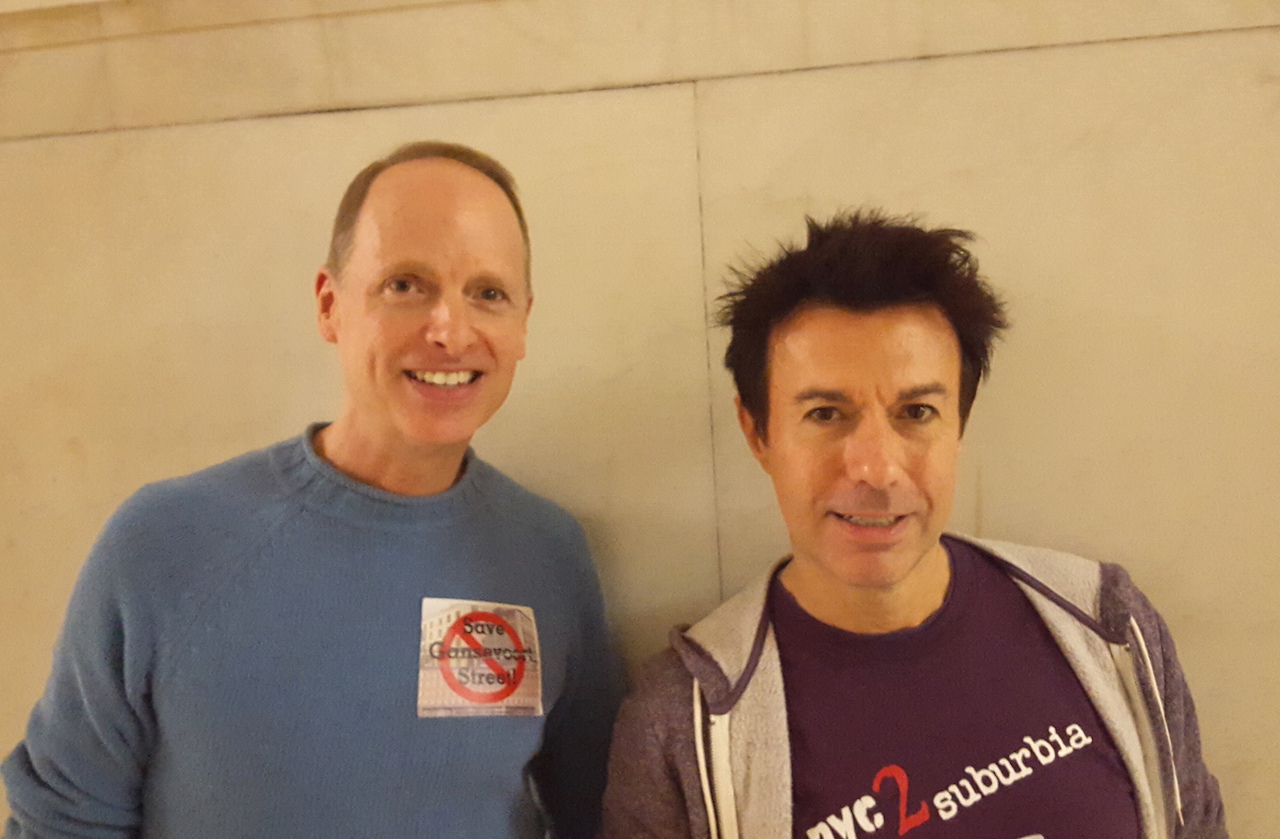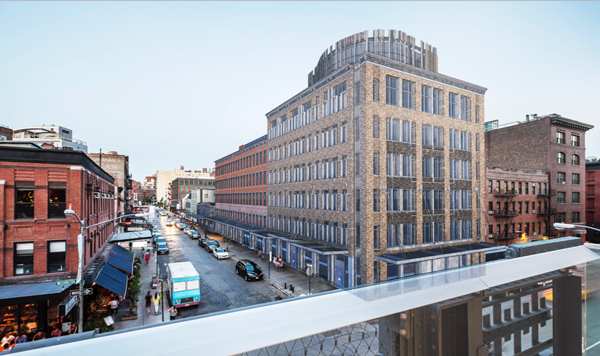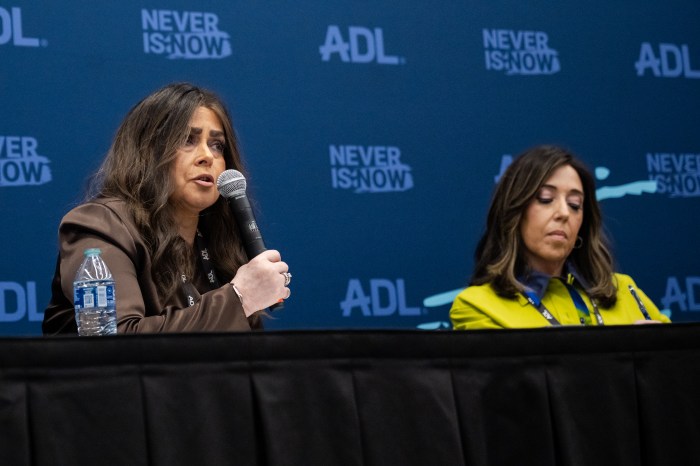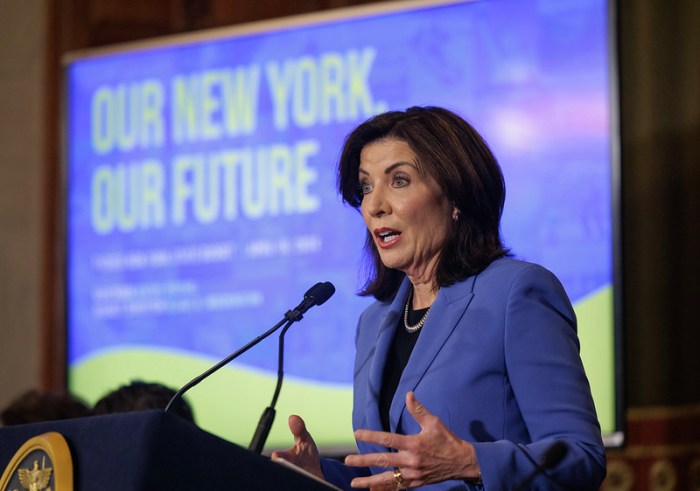
BY LUCAS ROPEK | A crowd of Village residents packed the Landmarks Preservation Commission meeting on Tues., Feb. 9, to express disapproval for a development plan that would dramatically upzone a block of historic Gansevoort St.
The development scheme is being led by William Gottlieb Real Estate and Aurora Capital Associates, and calls for demolishing several of the historic buildings along the block, as well as adding stories atop the remaining existing structures.
Unlike an L.P.C. meeting on Nov. 10 at which scores of residents were given an opportunity to speak out against the project, the meeting this Tuesday afternoon was strictly a dialogue between the L.P.C. commissioners and the developers, and was an opportunity for representatives of BKSK Architecture to respond on the developers’ behalf to locals’ complaints about the proposal.
Although effectively muzzled, opponents nevertheless wore “Save Gansevoort” stickers as a form of silent protest. They were more than happy to express their discontent to The Villager.
“I’m horrified,” said Jill Liebman, who lives on Horatio St. right around the corner from where the development would take place. A resident there for more than 43 years, Liebman said there was “no purpose whatsoever” for the new buildings, and that they would cater strictly to an upper-class clientele.
“All it is is greed,” she said. “No one can live here anymore. Only rich people can live in our neighborhood.”
That criticism was a recurring theme among the protesters who spoke out to this newspaper before the meeting.
“Everybody wants to make money, but there’s a limit,” said longtime local Vin Zappacosta, who felt that the proposed project was more about making money than preserving the area’s heritage.
“You have to keep in mind the community and the people in it,” he said. “Otherwise it’s not a neighborhood anymore — it’s just a business.”
At the meeting, L.P.C. Chairperson Meenakshi Srinivasan outlined the proposed developments before turning things over to Harry Kendall, a partner at BKSK and the project director for the Gansevoort St. development.
Kendall said he appreciated the “passion” that locals had expressed at the Nov. 10 meeting, yet also said he believed the plans would be satisfactory to the community. He then gave a powerpoint presentation meant to illustrate Gansevoort St.’s longstanding heritage of varying architectural styles — basically arguing that drastically changing the block’s appearance was consistent with its history of renovation and transformation.

If the commissioners’ reactions to the presentation were not nearly as negative as the opponents’, they weren’t exactly supportive, either. In particular, the design of the planned new construction was consistently panned by the commissioners.
In particular, a penthouse that the developers plan to construct atop the westernmost building became the object of significant heckling, with one commissioner suggesting that it should “disappear, quickly” — a sentiment that brought quiet chortles, and was echoed by others.
“You should get rid of the penthouse,” Srinivasan offered bluntly, at the meeting’s end.
While still respecting the developers’ intent to bring a new vibrancy and character to the block, the commissioners also used words like “fussy,” “out of place,” “gratuitous” and “inconsistent” to characterize the design plans.
In particular, Commissioner Michael Goldblum was critical of what he called the project’s “urbane” look.
“The architecture in this district is basic and simple and industrial in quality,” he said of the landmarked Gansevoort Historic District. On the other hand, he referred to the “sophisticated and finessed detailing” of BKSK’s plan, indicating he felt it was inconsistent with the overall feel of its surroundings.
“This style just doesn’t feel at home here,” he said.
After each commissioner had said his or her piece, Srinivasan ended the meeting by suggesting that the size and height of several of the proposed buildings be “scaled back,” that their style be “simplified,” and that the “fussy” canopies for several of the structures be rethought.
The meeting concluded with the suggestion by L.P.C. that developers come back with a revised plan, at which point further action could be taken.
Even with this lukewarm assessment by Landmarks, Village residents still felt that the commission’s criticism of the design did not go far enough.
Longtime local Donna Raftery, who has lived in the district more than 25 years, said afterward that she felt the commissioners’ reactions were “disappointing,” and that she had hoped for a far stronger defense of the existing buildings’ style and height.
“We are very disappointed,” said Andrew Berman, executive director of the Greenwich Village Society for Historic Preservation, one of the leading opponents of the project.
“While the changes the L.P.C. asked for are an improvement, the proposal was fundamentally flawed and should have been sent back to the drawing board,” Berman said. “The demolition and scale of development and additions that the commission indicated they are willing to approve are totally inappropriate for this iconic street in the heart of this historic district.”
















